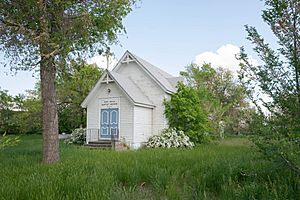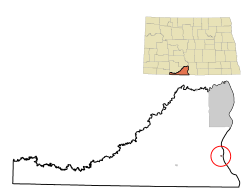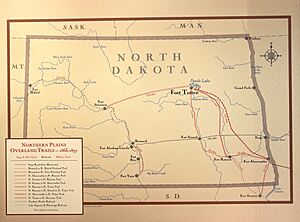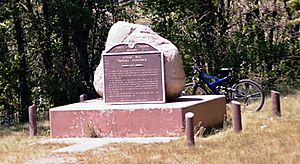Fort Yates, North Dakota facts for kids
Quick facts for kids
Fort Yates, North Dakota
|
|
|---|---|

Fort Yates Baptist Mission in Fort Yates
|
|

Location of Fort Yates, North Dakota
|
|
| Country | United States |
| Indian Reservation | Standing Rock Indian Reservation |
| State | North Dakota |
| County | Sioux |
| Founded | 1863 |
| Area | |
| • Total | 0.06 sq mi (0.16 km2) |
| • Land | 0.06 sq mi (0.16 km2) |
| • Water | 0.00 sq mi (0.00 km2) |
| Elevation | 1,634 ft (498 m) |
| Population
(2020)
|
|
| • Total | 176 |
| • Estimate
(2022)
|
169 |
| • Density | 2,933.33/sq mi (1,126.65/km2) |
| Time zone | UTC-6 (Central (CST)) |
| • Summer (DST) | UTC-5 (CDT) |
| ZIP code |
58538
|
| Area code(s) | 701 |
| FIPS code | 38-27860 |
| GNIS feature ID | 1036043 |
Fort Yates is a small city in North Dakota, United States. It is located in Sioux County. This city is the main center for the Standing Rock Sioux Tribe. It is also the county seat of Sioux County. In 2020, about 176 people lived here. The number of people living in Fort Yates has gone down since 1970. Many people moved away to find jobs elsewhere.
Contents
History of Fort Yates
Early Days and the Army Post
Fort Yates began as a Native American settlement. A US Army post was built here in 1863. It was first called Standing Rock Cantonment. The army's job was to watch over different groups of the Lakota Oyate. These groups included the Hunkpapa, Blackfeet, Inhunktonwan, and Cuthead.
In 1878, the US Army changed the fort's name. They named it after Captain George Yates. He was killed by the Lakota Oyate in the Battle of Little Big Horn in 1876. The town that grew around the fort also became known as Fort Yates. The army post closed down in 1903.
Sitting Bull and the Ghost Dance
Fort Yates was also the main office for the US Standing Rock Indian Agency. In the late 1800s, James McLaughlin was in charge here. He was worried about the Hunkpapa Lakota chief, Sitting Bull. Sitting Bull might have been part of the Ghost Dance movement.
So, McLaughlin ordered Sitting Bull's arrest on December 14, 1890. During the arrest, Sitting Bull was shot and killed. This happened at dawn in his log cabin. The police who shot him were Dakota, but not Hunkpapa.
Sitting Bull's Burial and Legacy
Sitting Bull was first buried at Fort Yates. But in 1953, his family decided to move his remains. They moved them to a new burial site in Mobridge, South Dakota. This new site overlooks the Missouri River, near where he was born.
There is a monument dedicated to Sitting Bull at his first burial site in Fort Yates. Another monument, with his bust, is at the Mobridge site. It also looks out over the Missouri River.
Today, Fort Yates is the main center for the Standing Rock Sioux Tribe. This tribe is officially recognized by the government. The tribe founded Sitting Bull College in Fort Yates. This college is named after their famous leader. It is the largest voting area on the reservation.
Geography and Climate
Where is Fort Yates Located?
Fort Yates is located on the western bank of Lake Oahe. The United States Census Bureau says the city is very small. It covers about 0.16 square kilometers (0.06 square miles). All of this area is land.
Understanding the Climate of Fort Yates
Fort Yates has a semiarid climate. This means it gets hot summers. Winters are cold and very dry. However, sometimes warm chinook winds can make winters milder. There are also big changes in temperature between day and night.
On February 2, 1992, Fort Yates had a record high temperature of 72°F (22°C). This was the highest temperature ever recorded for any winter month in North Dakota. The climate here is quite unique. It sits where several different climate types meet.
| Climate data for Fort Yates, North Dakota (1981-2010) | |||||||||||||
|---|---|---|---|---|---|---|---|---|---|---|---|---|---|
| Month | Jan | Feb | Mar | Apr | May | Jun | Jul | Aug | Sep | Oct | Nov | Dec | Year |
| Record high °F (°C) | 64 (18) |
72 (22) |
85 (29) |
99 (37) |
107 (42) |
110 (43) |
119 (48) |
111 (44) |
107 (42) |
95 (35) |
80 (27) |
69 (21) |
119 (48) |
| Mean daily maximum °F (°C) | 27.3 (−2.6) |
32.5 (0.3) |
43.3 (6.3) |
59.2 (15.1) |
70.4 (21.3) |
80.1 (26.7) |
87.1 (30.6) |
86.0 (30.0) |
74.2 (23.4) |
60.8 (16.0) |
42.3 (5.7) |
29.4 (−1.4) |
57.8 (14.3) |
| Daily mean °F (°C) | 14.6 (−9.7) |
19.9 (−6.7) |
30.5 (−0.8) |
41.1 (5.1) |
56.0 (13.3) |
65.6 (18.7) |
72.0 (22.2) |
70.4 (21.3) |
58.8 (14.9) |
46.1 (7.8) |
30.5 (−0.8) |
17.8 (−7.9) |
44.0 (6.7) |
| Mean daily minimum °F (°C) | 2.0 (−16.7) |
7.3 (−13.7) |
17.6 (−8.0) |
28.9 (−1.7) |
41.5 (5.3) |
51.2 (10.7) |
56.9 (13.8) |
54.8 (12.7) |
43.4 (6.3) |
31.3 (−0.4) |
18.6 (−7.4) |
6.1 (−14.4) |
30.1 (−1.1) |
| Record low °F (°C) | −41 (−41) |
−50 (−46) |
−33 (−36) |
−7 (−22) |
16 (−9) |
28 (−2) |
28 (−2) |
29 (−2) |
15 (−9) |
−4 (−20) |
−23 (−31) |
−34 (−37) |
−50 (−46) |
| Average precipitation inches (mm) | 0.19 (4.8) |
0.32 (8.1) |
0.55 (14) |
1.04 (26) |
2.49 (63) |
2.83 (72) |
2.39 (61) |
1.57 (40) |
1.49 (38) |
1.30 (33) |
0.43 (11) |
0.23 (5.8) |
14.83 (376.7) |
| Average snowfall inches (cm) | 6.1 (15) |
9.6 (24) |
11.3 (29) |
2.3 (5.8) |
0.0 (0.0) |
0.0 (0.0) |
0.0 (0.0) |
0.0 (0.0) |
0.0 (0.0) |
0.3 (0.76) |
2.0 (5.1) |
4.8 (12) |
36.2 (92) |
| Source: NOAA, WRCC | |||||||||||||
Population and People
How Many People Live Here?
| Historical population | |||
|---|---|---|---|
| Census | Pop. | %± | |
| 1880 | 446 | — | |
| 1890 | 511 | 14.6% | |
| 1970 | 1,153 | — | |
| 1980 | 771 | −33.1% | |
| 1990 | 183 | −76.3% | |
| 2000 | 228 | 24.6% | |
| 2010 | 184 | −19.3% | |
| 2020 | 176 | −4.3% | |
| 2022 (est.) | 169 | −8.2% | |
| U.S. Decennial Census 2020 Census |
|||
In 2010, there were 184 people living in Fort Yates. These people lived in 66 households. About 43 of these were families. The city had about 3066.7 people per square mile. There were 73 housing units in total.
Who Lives in Fort Yates?
Most people in Fort Yates are Native American, making up 92.4% of the population. About 5.4% are White. A small number are from other backgrounds. About 2.2% of the people are Hispanic or Latino.
Many households (45.5%) had children under 18. About 22.7% were married couples. Some households (30.3%) had a female head with no husband. Others (12.1%) had a male head with no wife. About 34.8% were not families.
The average age in Fort Yates was 33.6 years old. About 31% of residents were under 18. About 9.8% were 65 or older. Slightly more than half (53.3%) of the people were male.
Water and Education
Fort Yates Water Treatment Plant
The water treatment plant in Fort Yates is very important. It is part of The Standing Rock Rural Water System. This plant provides drinking water for over three thousand people. This includes residents of Porcupine, Cannonball, and Fort Yates. It also supplies water to the Prairie Knights Casino and Lodge. The water comes from the Missouri River.
Schools in Fort Yates
Fort Yates is part of the Fort Yates School District. This school district works together with the Standing Rock Community School.
See also
 In Spanish: Fort Yates (Dakota del Norte) para niños
In Spanish: Fort Yates (Dakota del Norte) para niños




